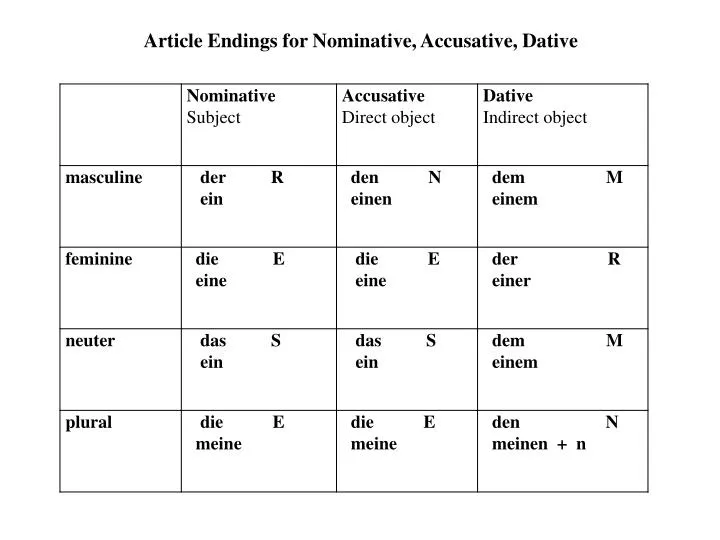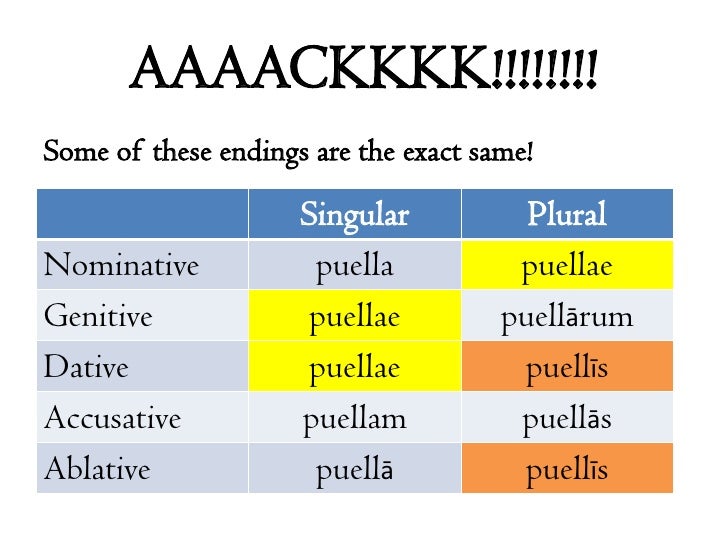
In Slovene literature, the declensions are defined by the ending in genitive singular, but in international literature, the nouns are often divided by the stem (the same way as in Proto-Slavic), which are more numerous.

A number of feminine nouns end in a consonant these are mostly "i-stem" and "v-stem" nouns. Feminine nouns usually end in -a these are the "a-stem" nouns.Masculine nouns typically end in a consonant, although a few end in a vowel, mostly in -a, -o and -i (some names, letters, nominalized adjectives etc.).Non-native speakers in most cases determine try to determine gender from the ending of a noun in nominative singular. Note that the feminine singular and neuter plural endings are the same so the number must be determined first. Since some nouns can only have a singular form and some only a plural form (extremely rarely also only dual, such as ribi ' pisces'), both singular and plural endings must be remembered. Native speakers usually identify a gender by placing a demonstrative pronoun tisti 'that' in front of it. sp.) which is in some dialects masculinized or feminized. sp.) divided further into animate (accusative singular equals genitive) and inanimate (accusative singular equals nominative) in the first and fourth masculine declension, and in first adjective declension. (Both parents have to sign the application.) – dual is used.Ī noun in Slovene can have one of the following three genders: Na vpisnico se morata podpisati oba starša.(I asked parents if I can go out.) – plural is used. Starše sem vprašal, če lahko grem ven.Plural is used instead of dual for nouns that represent things that usually come in pairs (such as body parts, socks, twins, and parents), except if one wants to stress that the noun relates to both parts and after words that signify a pair (such as oba 'both', etc. There is, however, an exception to that rule. Plural ( množina), which refers to more than two objects.Dual ( dvojina), which refers to a pair of objects.Singular ( ednina), which refers to one object.

While having the same endings, it is still tonemically different from the nominative case, always having circumflex accent, but because of its similarity with nominative, it is often omitted from declension tables or is considered a special case of nominative, called 'addressive nominative' ( ogovorni imenovalnik) in Slovene literature. Colloquially, vocative endings are still present, but the current use is taken from Serbo-Croatian. Some words, however, kept the vocative form, such as oče (instead of the nominative *otь̀cь) 'father'. Vocative ( zvalnik or vokativ) was used with the original endings in Slovene up to the 18th century by, for example Janez Svetokriški, but has now received the endings of the nominative case. Where it is not otherwise noted, the second form is in genitive singular form. For this reason, genitive singular form is commonly written with the nominative. The nouns are usually listed and sorted by their nominative singular form, but declension is defined by the genitive singular form. They are also usually numbered accordingly: the nominative case is the first case, the genitive the second, and so on. Traditionally, the cases are given in the order above.

This page describes the declension of nouns, adjectives and pronouns in Slovene.


 0 kommentar(er)
0 kommentar(er)
